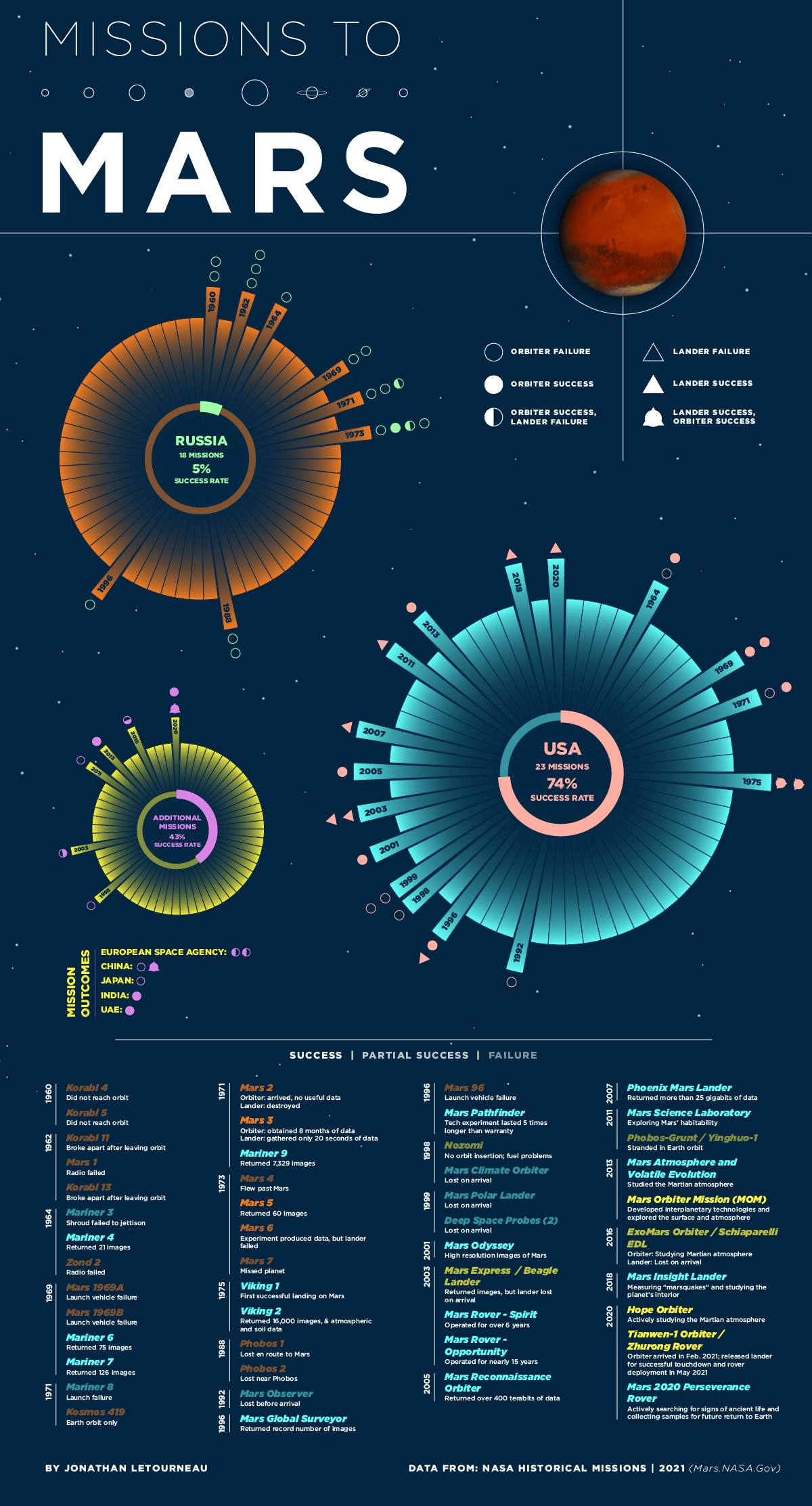Space
Every Mission to Mars in One Visualization

Timeline: A Historical Look at Every Mission to Mars
Within our Solar System, Mars is one of the most similar planets to Earth—both have rocky landscapes, solid outer crusts, and cores made of molten rock.
Because of its similarities to Earth and proximity, humanity has been fascinated by Mars for centuries. In fact, it’s one of the most explored objects in our Solar System.
But just how many missions to Mars have we embarked on, and which of these journeys have been successful? This graphic by Jonathan Letourneau shows a timeline of every mission to Mars since 1960 using NASA’s historical data.
A Timeline of Mars Explorations
According to a historical log from NASA, there have been 48 missions to Mars over the last 60 years. Here’s a breakdown of each mission, and whether or not they were successful:
| # | Launch | Name | Country | Result |
|---|---|---|---|---|
| 1 | 1960 | Korabl 4 | USSR (flyby) | Failure |
| 2 | 1960 | Korabl 5 | USSR (flyby) | Failure |
| 3 | 1962 | Korabl 11 | USSR (flyby) | Failure |
| 4 | 1962 | Mars 1 | USSR (flyby) | Failure |
| 5 | 1962 | Korabl 13 | USSR (flyby) | Failure |
| 6 | 1964 | Mariner 3 | US (flyby) | Failure |
| 7 | 1964 | Mariner 4 | US (flyby) | Success |
| 8 | 1964 | Zond 2 | USSR (flyby) | Failure |
| 9 | 1969 | Mars 1969A | USSR | Failure |
| 10 | 1969 | Mars 1969B | USSR | Failure |
| 11 | 1969 | Mariner 6 | US (flyby) | Success |
| 12 | 1969 | Mariner 7 | US (flyby) | Success |
| 13 | 1971 | Mariner 8 | US | Failure |
| 14 | 1971 | Kosmos 419 | USSR | Failure |
| 15 | 1971 | Mars 2 Orbiter/Lander | USSR | Failure |
| 16 | 1971 | Mars 3 Orbiter/Lander | USSR | Success/Failure |
| 17 | 1971 | Mariner 9 | US | Success |
| 18 | 1973 | Mars 4 | USSR | Failure |
| 19 | 1973 | Mars 5 | USSR | Success |
| 20 | 1973 | Mars 6 Orbiter/Lander | USSR | Success/Failure |
| 21 | 1973 | Mars 7 Lander | USSR | Failure |
| 22 | 1975 | Viking 1 Orbiter/Lander | US | Success |
| 23 | 1975 | Viking 2 Orbiter/Lander | US | Success |
| 24 | 1988 | Phobos 1 Orbiter | USSR | Failure |
| 25 | 1988 | Phobos 2 Orbiter/Lander | USSR | Failure |
| 26 | 1992 | Mars Observer | US | Failure |
| 27 | 1996 | Mars Global Surveyor | US | Success |
| 28 | 1996 | Mars 96 | Russia | Failure |
| 29 | 1996 | Mars Pathfinder | US | Success |
| 30 | 1998 | Nozomi | Japan | Failure |
| 31 | 1998 | Mars Climate Orbiter | US | Failure |
| 32 | 1999 | Mars Polar Lander | US | Failure |
| 33 | 1999 | Deep Space 2 Probes (2) | US | Failure |
| 34 | 2001 | Mars Odyssey | US | Success |
| 35 | 2003 | Mars Express Orbiter/Beagle 2 Lander | ESA | Success/Failure |
| 36 | 2003 | Mars Exploration Rover - Spirit | US | Success |
| 37 | 2003 | Mars Exploration Rover - Opportunity | US | Success |
| 38 | 2005 | Mars Reconnaissance Orbiter | US | Success |
| 39 | 2007 | Phoenix Mars Lander | US | Success |
| 40 | 2011 | Mars Science Laboratory | US | Success |
| 41 | 2011 | Phobos-Grunt/Yinghuo-1 | Russia/China | Failure |
| 42 | 2013 | Mars Atmosphere and Volatile Evolution | US | Success |
| 43 | 2013 | Mars Orbiter Mission (MOM) | India | Success |
| 44 | 2016 | ExoMars Orbiter/Schiaparelli EDL Demo Lander | ESA/Russia | Success/Failure |
| 45 | 2018 | Mars InSight Lander | US | Success |
| 46 | 2020 | Hope Orbiter | UAE | Success |
| 47 | 2020 | Tianwen-1 Orbiter/Zhurong Rover | China | Success |
| 48 | 2020 | Mars 2020 Perseverance Rover | US | Success |
The first mission to Mars was attempted by the Soviets in 1960, with the launch of Korabl 4, also known as Mars 1960A.
As the table above shows, the voyage was unsuccessful. The spacecraft made it 120 km into the air, but its third-stage pumps didn’t generate enough momentum for it to stay in Earth’s orbit.
For the next few years, several more unsuccessful Mars missions were attempted by the USSR and then NASA. Then, in 1964, history was made when NASA launched the Mariner 4 and completed the first-ever successful trip to Mars.
The Mariner 4 didn’t actually land on the planet, but the spacecraft flew by Mars and was able to capture photos, which gave us an up-close glimpse at the planet’s rocky surface.
Then on July 20, 1976, NASA made history again when its spacecraft called Viking 1 touched down on Mars’ surface, making it the first space agency to complete a successful Mars landing. Viking 1 captured panoramic images of the planet’s terrain, and also enabled scientists to monitor the planet’s weather.
Vacation to Mars, Anyone?
To date, all Mars landings have been done without crews, but NASA is planning to send humans to Mars by the late 2030s.
And it’s not just government agencies that are planning missions to Mars—a number of private companies are getting involved, too. Elon Musk’s aerospace company SpaceX has a long-term plan to build an entire city on Mars.
Two other aerospace startups, Impulse and Relativity, also announced an unmanned joint mission to Mars in July 2022, with hopes it could be ready as soon as 2024.
As more players are added to the mix, the pressure is on to be the first company or agency to truly make it to Mars. If (or when) we reach that point, what’s next is anyone’s guess.

This article was published as a part of Visual Capitalist's Creator Program, which features data-driven visuals from some of our favorite Creators around the world.
Technology
Which Companies Own the Most Satellites?
Despite Starlink’s dominance in the industry, the company is set to face intense competition in the coming years.

Which Companies Own the Most Satellites?
Nearly 7,000 satellites orbit the Earth, serving vital functions such as communication, navigation, and scientific research.
In 2022 alone, more than 150 launches took place, sending new instruments into space, with many more expected over the next decade.
But who owns these objects? In this graphic, we utilize data from the Union of Concerned Scientists to highlight the leaders in satellite technology.
SpaceX’s Dominance in Space
SpaceX, led by Elon Musk, is unquestionably the industry leader, currently operating the largest fleet of satellites in orbit—about 50% of the global total.
The company has already completed 62 missions this year, surpassing any other company or nation, and operates thousands of internet-beaming Starlink spacecraft that provide global internet connectivity.
Starlink customers receive a small satellite dish that self-orients itself to align with Starlink’s low-Earth-orbit satellites.
| Owner | Total | Share | Country |
|---|---|---|---|
| SpaceX | 3,395 | 50% | USA |
| OneWeb Satellites | 502 | 7% | UK |
| Chinese Government | 369 | 5% | China |
| U.S. Government | 306 | 4% | USA |
| Planet Labs, Inc. | 195 | 3% | USA |
| Russian Federation | 137 | 2% | Russia |
| Spire Global Inc. | 127 | 2% | USA |
| Swarm Technologies | 84 | 1% | USA |
| Iridium Communications, Inc. | 75 | 1% | USA |
| Other | 1,528 | 23% |
Percentages may not add to 100 due to rounding.
In second place is a lesser-known company, British OneWeb Satellites. The company, headquartered in London, counts the UK government among its investors and provides high-speed internet services to governments, businesses, and communities.
Like many other satellite operators, OneWeb relies on SpaceX to launch its satellites.
Despite Starlink’s dominance in the industry, the company is set to face intense competition in the coming years. Amazon’s Project Kuiper plans to deploy 3,236 satellites by 2029 to compete with SpaceX’s network. The first of the fleet could launch as early as 2024.
The Rise of China’s Space Program
After the top private companies, governments also own a significant portion of satellites orbiting the Earth. The U.S. remains the leader in total satellites, when adding those owned by both companies and government agencies together.
American expenditures on space programs reached $62 billion in 2022, five times more than the second one, China.
China, however, has sped up its space program over the last 20 years and currently has the highest number of satellites in orbit belonging directly to government agencies. Most of these are used for Earth observation, communications, defense, and technology development.
Satellite Demand to Rise Over the Decade
Despite the internet being taken for granted in major metropolitan areas and developed countries, one out of every three people worldwide has never used the web.
Furthermore, the increasing demand for data and the emergence of new, more cost-effective satellite technologies are expected to present significant opportunities for private space companies.
In this context, satellite demand is projected to quadruple over the next decade.
-

 Technology2 weeks ago
Technology2 weeks agoRanked: The Most Popular Smartphone Brands in the U.S.
-

 Automotive1 week ago
Automotive1 week agoAlmost Every EV Stock is Down After Q1 2024
-

 Money1 week ago
Money1 week agoWhere Does One U.S. Tax Dollar Go?
-

 Green2 weeks ago
Green2 weeks agoRanked: Top Countries by Total Forest Loss Since 2001
-

 Real Estate2 weeks ago
Real Estate2 weeks agoVisualizing America’s Shortage of Affordable Homes
-

 Maps2 weeks ago
Maps2 weeks agoMapped: Average Wages Across Europe
-

 Mining2 weeks ago
Mining2 weeks agoCharted: The Value Gap Between the Gold Price and Gold Miners
-

 Demographics2 weeks ago
Demographics2 weeks agoVisualizing the Size of the Global Senior Population












